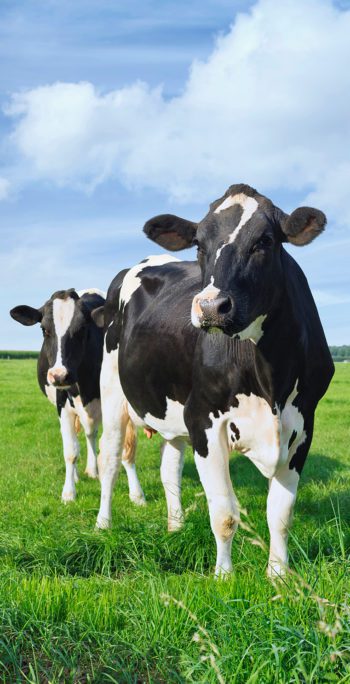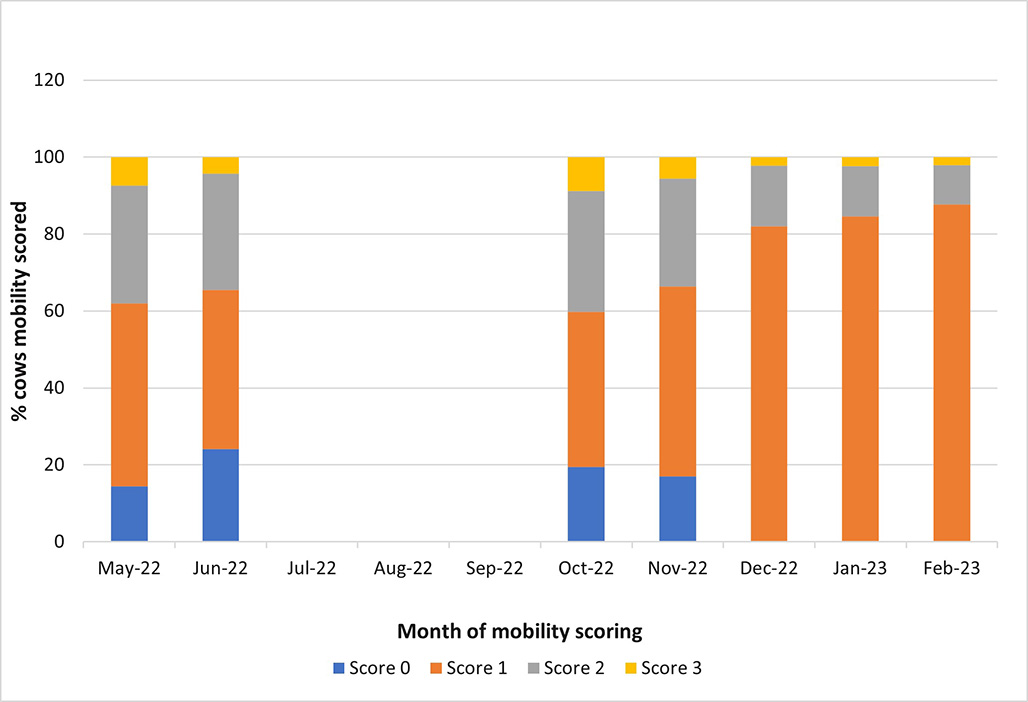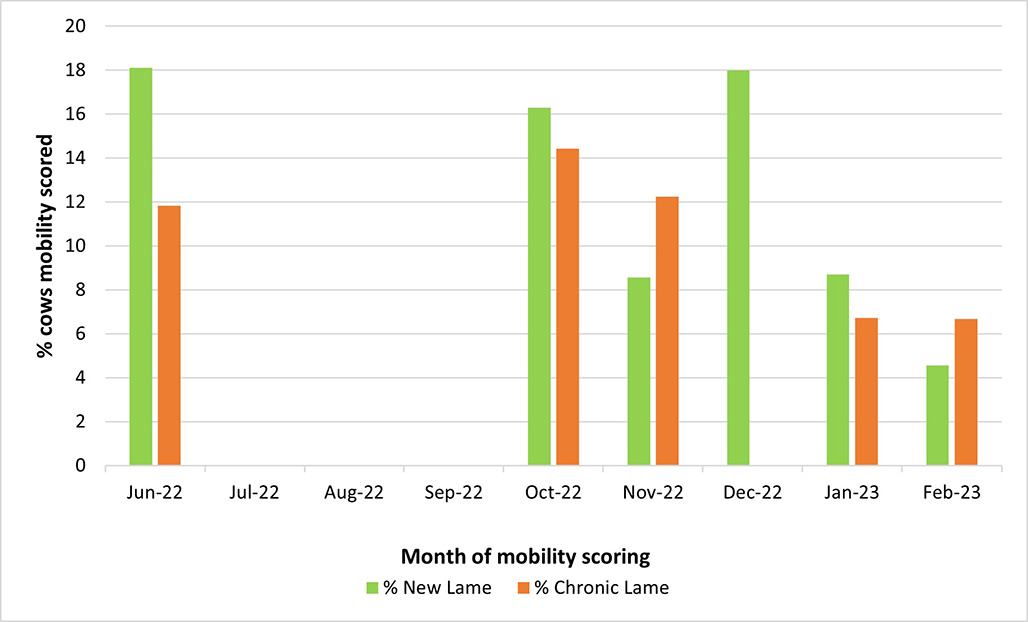30 Apr 2024
Jessica Reynolds considers management and environmental factors for treating and preventing lameness in the second part of this series on dairy cows.

“Routine foot ‘inspection’ has proven cost-benefit to herds with increased lameness prevalence.” Image © Parilov / Adobe Stock
In the first article of this two-part series (VTL10.1) covering an evidence-based approach for investigating lameness in the dairy herd, an example herd case of a 300-cow dairy herd reporting increased lameness prevalence was assessed.
On analysis of mobility score and lameness treatment data, the main causative lesions of lameness were found to be sole ulcer and sole haemorrhage claw horn lesions (CHLs), with decreased frequency of detection and delayed inadequate treatment of new cases.
Housing assessment revealed no additional cubicles for cow numbers and poor cubicle design, increasing risk of prolonged standing time and contributing to CHL development.
The challenges associated with making successful change on farm have long been discussed in farm practice.
Recent literature has described the importance of making recommendations practically feasible and in line with current farmer motivations, with the need to foster trust and farmer engagement for successful enactment of change on farm (Bard et al, 2019).

Mobility scoring was intermittent in this example herd, with no alignment with a foot trimmer visit and foot trimming performed every six weeks, with routine trims and chronic case treatments prioritised.
Fortnightly mobility scoring and prioritisation of treatment of newly lame (score 2 and 3), rather than chronically lame cases using the Dutch five-step trimming method (Toussaint Raven, 1985), has been demonstrated to reduce prevalence and severity of lameness, when compared to groups with less frequent assessment (Groenevelt et al, 2014).

Furthermore, treating newly lame cows every six weeks versus fortnightly significantly reduces the chance of cure after treatment and increases risk of development of chronic cases (Thomas et al, 2015; 2016). Chronic lame cows have a low response rate to any treatment given once lameness duration is longer than two weeks (Thomas et al, 2016) and are predisposed to future cases, contributing significantly to herd lameness prevalence (Randall et al, 2018). Repeated cases are associated with scarring and a reduced volume of the digital cushion (Wilson et al, 2021).
Routine foot “inspection” has proven cost-benefit to herds with increased lameness prevalence in reducing lameness prevalence and improving cow welfare (Manning et al, 2016), although less so in chronically lame cows (Daros et al, 2019).
Consequently, fortnightly mobility scoring with foot trimmer visits targeting newly or severely lame cattle following within 24 hours of mobility scoring was advised, to maintain welfare and maximise cure rates (Pedersen and Wilson, 2021).
Newly or severely lame cows between foot trimming sessions were advised to be trimmed on an additional foot trimmer, or routine vet visit, until farm staff had received formal training and invested in foot trimming equipment.
Incorporation of routine inspection into the trimmer visit was not recommended to enable prioritisation of newly and very lame cow examination. A separate visit was advised for annual routine foot inspection (Pedersen and Wilson, 2021).
At the time of the initial investigation, use of NSAIDs was limited for lame cows in this herd, with alleviation of pressure from the affected claw with CHL using a block only for cows with a sole ulcer.
Evidence demonstrates that cows with a single CHL have the highest lameness cure rate if they receive an NSAID injection in combination with a therapeutic trim and block placement on the contralateral claw. This had the largest impact in newly and mildly lame cattle (Thomas et al, 2015).
It is hypothesised that NSAIDs help regression of new CHL by reducing localised inflammation of the corium that stimulates distal phalanx exostoses with potential to perpetuate further corium trauma (Wilson et al, 2022). Therefore, it was advised that every lame cow, whether new or chronically lame, received NSAID administration. Furthermore, all cattle with any type of CHL were advised to receive a contralateral claw block.
“A significant proportion of farmers are not aware of the direct and indirect costs associated with lameness, with 70% underestimating the economic impact on their herd.”
The cubicle brisket board placement in this herd led to inadequate lunging space at the cubicle front (0.5m; see Table 1 in part 1, VTL10.1). This resulted in cows either struggling to stand after lying or not lying at all, increasing standing times (Espejo and Endres, 2007).
Optimum cubicle lunge zone is 0.9m, as this enables normal standing posture (Leach and Whay, 2009); therefore, it was advised to move the brisket board back 0.2m to enable cows to rise more easily after lying and encourage cubicle use, reducing the diagonal lying posture that decreased cubicle comfort.
The cubicle bedding substrate used was 1kg straw, topping rubber mattresses. It is reported in literature that cows housed on deep-sand cubicles had increased occupancy and lying times compared to those bedded on mattresses (Gomez and Cook, 2010), with a lower incidence of lameness (Andreasen and Forkman, 2012).
Therefore, installation of deep-sand bed cubicles was introduced as a long-term goal for this farm. However, costs are associated with sand cubicle conversion and slurry handling (Bicalho and Oikonomou, 2013), and additional straw alone in cubicles has been demonstrated to increase daily cubicle lying times by up to 1.3 hours (Tucker et al, 2009).
Consequently, application of an additional 6kg straw to current mattresses was advised when bedding, to maximise cubicle comfort and increase occupancy in the short to medium term. Most importantly, cubicle stocking rate was identified as 100% for all milking cows in this herd. Stocking rate of 100% with no additional cubicles has long been reported as increasing risk of CHL development (Leonard et al, 1996), primarily by increasing standing time (Fregonesi et al, 2007).
Installation of 5% to 10% additional cubicles to cow numbers was discussed as a long-term aspiration, with a medium-term goal of increasing space allowance and improving cow flow to reduce pressure on the current cubicles.
Current living space measured in milking cow housing was 2.9m² living space per cow, with the herd ranked as 35th out of a random sample of 51 UK farms (Thompson et al, 2020; Figure 1). No targets exist for this novel measure; however, opening the ends of housing and increasing overall space available would reduce “dead ends” where subordinate cows were congregating, and improve cow flow around the end of the feed trough.
Subordinate cows are at increased risk of passageway standing – especially with concurrent increased stocking rate, increasing incidence of solar lesions in these animals (Webster, 2002).
It was recommended that increasing living space to 4.8m² per cow (increasing herd ranking to 47th out of 51 UK farms) by opening a loafing space outside the milking sheds with pre-existing electric fencing would help reduce pressure on current cubicle number and improve cow flow, reducing cow congregation (Figure 2).
Increased frequency of veterinary data discussion and follow up of on-farm recommendations has been directly linked to increased farmer readiness to adopt on-farm changes (Ritter et al, 2019); therefore, a minimum of a three-month follow up to reassess farm data and check in on recommendation progress is suggested.
A follow-up visit for this herd three months later revealed that mobility scoring visits had been increased to monthly frequency, with foot trimmer visits prioritising new score 2 and 3 cows occurring within 48 hours of these.
The farm was also trimming newly lame cows between trimmer visits with an improved handling system. NSAIDs were administered to every lame cow, and contralateral claw blocks used to alleviate pressure from CHL. The advised outdoor loafing space was also being successfully used, despite initial misgivings about practicality from the farm.
The cubicle brisket board was yet to be altered; however, 4kg of straw was now being applied to cubicle mattresses. Analysis of mobility score data (Figures 3a and 3b) demonstrates the impact of improved detection and treatment of lameness and environmental changes.


Continued monitoring of mobility score data was recommended to ensure the trend continues and that prevention strategies advised continued to decrease lameness prevalence. Longer term, increased cubicle number and comfort, alongside increasing frequency of mobility scoring and foot trimming to fortnightly, was strongly advised to help both decrease prevalence of new lesions and maximise speed of detection and treatment.
Alongside the obvious welfare implications, the projected financial impact of lameness on this farm was very significant, with a total cost of £76,299 estimated for the past 12 months’ worth of lesions recorded.
A significant proportion of farmers are not aware of the direct and indirect costs associated with lameness, with 70% underestimating the economic impact on their herd.
The cost of the recommended fortnightly surveillance and treatment protocol with annual herd inspection has been reviewed in literature, and breaks even at a herd lameness prevalence of 12%, proving cost effective up to a 50% prevalence (Groenevelt et al, 2014). The cost of other proposed recommendations was also much less than the annual estimated economic impact of CHL on this farm, amounting to £13,433 on an annual basis for brisket board movement, provision of additional living space and straw.
This case demonstrates the value of early recognition and treatment of lameness combined with regular reassessment of lameness data, and two-way farmer-clinician dialogue about progress.
This approach enabled successful and sustainable enactment of change on farm, enabling key trends in mobility on farm to be identified and impact of changes made to be demonstrated and continually monitored, as an iterative process.